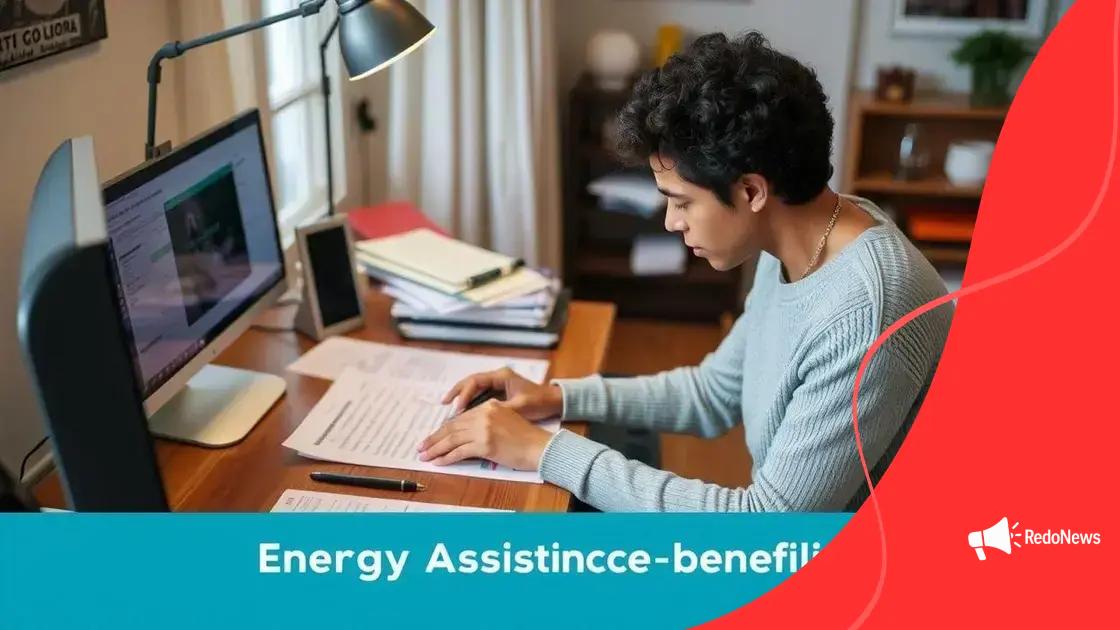Home energy aid: Awareness rising for families in need

Home energy aid programs provide essential financial assistance to families struggling with energy bills, improving their financial stability and promoting energy efficiency in their homes.
Home energy aid: Awareness rising has become increasingly vital for families struggling with energy costs. Many may wonder how these programs can ease their financial burden and improve their quality of life.
Understanding home energy aid
Understanding home energy aid is essential for families looking to manage their energy costs effectively. Many households face challenges in keeping their homes warm in the winter or cool in the summer due to rising utility bills. Programs designed to provide assistance can help alleviate some of this financial stress.
Types of Home Energy Aid
There are various programs that offer support for families. These can vary by state and may include federal, state, or local initiatives. It’s important to explore all options available to you.
- Low-Income Home Energy Assistance Program (LIHEAP)
- Weatherization Assistance Program
- Utility company assistance programs
- State or local emergency aid programs
Each program has different criteria and benefits, so it’s crucial to understand what you may qualify for. Home energy aid can significantly impact a family’s budget, making it vital to stay informed about available resources.
How Aid Programs Work
An aid program typically requires the household to provide information about its income and energy costs. Once your application is approved, assistance can come in several forms. For example, you might receive direct monetary assistance to cover energy bills or enhancements to your home for energy efficiency.
These improvements can lead to reduced utility bills and a more comfortable living environment. By enrolling in programs focused on home energy aid, families can not only find immediate relief but also create long-term savings on their energy expenses. Staying proactive and informed is key.
Eligibility for assistance programs
Eligibility for assistance programs is an important aspect for families seeking home energy aid. Understanding the requirements helps ensure that those in need can access the support available. Many programs consider various factors, primarily focusing on household income and size.
Common Eligibility Criteria
Each program has its own set of guidelines, but generally, applicants may need to meet certain standards.
- Income limits based on household size
- Proof of residency
- Evidence of current energy costs
- Specific circumstances like disability or age
Gathering the right documentation is critical. You may need to provide tax returns or pay stubs to prove your income level. Knowing what to prepare can smooth the process of applying for assistance programs. Some programs also provide extra assistance to vulnerable groups.
Steps to Verify Eligibility
To determine your eligibility, you can start by visiting the official website of your local energy assistance program. Here, you can find the specific criteria and applications that apply to your area. Additionally, many charities and non-profit organizations offer resources to help families understand their options.
By exploring these options and asking questions, families can feel more confident about their assistance program applications. Often, local organizations provide assistance with the application process as well, making it easier to get the help you need.
How to apply for benefits

Applying for benefits related to home energy aid is a straightforward process if you know the steps. It’s important to gather necessary information to make your application efficient and successful. Start by checking the specific guidelines for the program you’re interested in, as they can vary significantly.
Gather Necessary Documentation
Before you apply, ensure you have all the documentation you need. This often includes:
- Proof of your income, like pay stubs or tax returns
- Utility bills showing your recent usage
- Identification, such as a driver’s license or state ID
- Proof of residency, like a lease agreement or mortgage statement
Having these documents ready can speed up the application process. If you are unsure about what you need, contact your local assistance program for guidance. Many organizations are willing to help individuals through this process.
Completing the Application
Applications for assistance programs can usually be completed online, by mail, or in person. When filling out your application, take your time and make sure all information is accurate. Small mistakes can delay the approval process.
Once you submit your application, tracking its progress is crucial. Some programs provide a way to check your application status online, while others may require a phone call. If you are approved, you will receive information on the benefits you will receive and how they will be applied.
Raising awareness in the community
Raising awareness in the community about home energy aid programs is essential for helping families access the support they need. Often, people may not know what resources are available to them, so education is key. Community events and local outreach can help spread the word.
Utilizing Local Resources
Local organizations play a big role in raising awareness. They can host workshops or informational sessions to discuss:
- What home energy aid programs exist
- Who is eligible for these programs
- How to apply for assistance
- Tips for reducing energy costs
By showcasing these topics, organizations can engage the community and empower families to seek help. They can also provide printed materials and flyers to share information in a clear and accessible way.
Collaborating with Stakeholders
Collaboration is vital for effectively raising awareness. Partnerships with local businesses, schools, and government agencies can help amplify the message. By working together, stakeholders can reach a broader audience and ensure key information is disseminated widely.
Using social media platforms can also enhance community outreach. Sharing stories of those who have benefited from assistance programs can inspire others to take action. Highlighting successes and ongoing efforts helps to foster a supportive community environment.
Long-term benefits of energy aid
The long-term benefits of energy aid programs can greatly impact families and communities. While immediate assistance helps reduce financial stress, the advantages extend beyond just paying bills. Understanding these benefits can encourage more families to seek help.
Improved Financial Stability
One of the primary long-term benefits is improved financial stability. By receiving support for energy costs, families can allocate their budgets more effectively. This allows them to invest in other important areas like education, healthcare, and savings. With reduced energy worries, many families find relief, enabling them to focus on building a brighter future.
Increased Energy Efficiency
Many energy aid programs offer additional services, such as home weatherization. This involves improving insulation and ensuring energy-efficient appliances are used. As a result, families can lower their energy consumption over time. This means not only lower bills but a reduced environmental footprint as well.
When homes are more energy-efficient, families enjoy a comfortable living environment year-round. This enhancement often leads to better health outcomes due to improved air quality and temperature regulation. Thus, energy aid plays a crucial role in promoting a healthier home.
Community Impact
The benefits of energy aid programs also ripple through the community. When families receive assistance, local economies can strengthen. Increased financial security allows families to spend more on local goods and services. Moreover, as communities become more energy-efficient, they contribute positively to environmental preservation.
FAQ – Frequently Asked Questions about Home Energy Aid Programs
What is home energy aid?
Home energy aid refers to programs that provide financial assistance to families struggling to pay their energy bills. These programs aim to help maintain a safe and comfortable living environment.
Who is eligible for energy assistance programs?
Eligibility typically depends on household income, family size, and specific energy costs. Many programs prioritize low-income households and those facing financial hardships.
How can I apply for energy assistance?
To apply, gather necessary documents like proof of income and recent utility bills. You can usually apply online or in person through your local energy assistance program.
What are the long-term benefits of receiving energy aid?
Long-term benefits include improved financial stability, increased energy efficiency in homes, and a positive impact on community economies.
